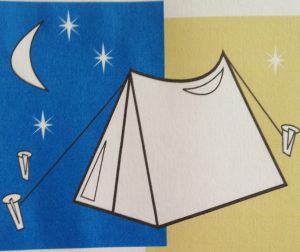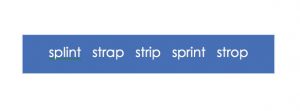
I have a love/hate relationship with consonant clusters! I love them, because, they tell me so much about the method used to teach a struggling reader, and why she is struggling.
But I dislike words with consonant clusters, because I know how hard they are for children who find reading difficult. Longer words with consonant clusters are even more of a problem. There are a few examples of words with consonant clusters in the blue box above.
Why are Small Words with Consonant Clusters so Difficult?
These words are difficult, because they have two consonants sitting side by side, e.g. tr st nt. Struggling readers, often leave one of these two sounds out, especially when one of these consonant cluster comes at the beginning of the word.
Educational Psychologists test struggling readers, hear this happen, and report that a child often ‘leaves sounds out when reading small words’. But they rarely explain why.
Why do Children Leave out Sounds in Consonant Clusters?
Children leave out one of the consonant sounds in a consonant cluster, because they cannot hear it. It is as simple as that. If you listen to the word bent you will hear the sounds b e and t clearly. However, sound n will be harder to hear: it is almost drowned out by the strong sound t.
This problem is very evident if you ask a child to write a word like bent. If she writes bet then you know she is struggling to hear the weak sound n in the cluster.
So Why are Children Taught Consonant Clusters?
Traditionally, children were made to rote learn consonant clusters, to try to make them easier to read. Over time, however, teachers realised memorising consonant clusters was a waste of time because there are so many of them. It didn’t seem to improve reading scores either.
Although this is no longer recommended, sadly, this practice lingers on in a few schools, making reading very difficult for children, when they come to sound out (segment) longer words.
It also makes spelling harder, because children then cannot separate the sounds in a consonant cluster, when they are trying to write a new word. A better way of overcoming these problems is to focus on basic reading skills.
Kick the Consonant Cluster Habit with your Child!
Your child may also be struggling with consonant clusters. This is an indication that she lacks basic reading skills.
It is not enough that she recognise the 4 letters: h a n d, she has to be able to push them together to HEAR the word hand (I deal with this in great detail in my Blog post on blending). This is where you can help your child.
Before you begin, please make sure your child is competent with three letter cvc words like cat dog van leg. These are covered in my blog post : If He Can’t Read Small Words, he wont read long ones!
Focus on Skills! Play with Sounds in Consonant Clusters!
It is important to remember that children learn skills through repeatedly ‘doing’: practise really does make perfect! Maybe you need to put the reading book away for a while (or you can read it to her)! In its place, get out the sticky notelets and big coloured pens and have fun!

Let’s do something useful & fun with Consonant Clusters

Take four sticky notelets and place them on the table in front of your child, sticky side along the bottom, so they will stand up a little. Tell your child you’re going to make a word together.
 Think of a simple word – children like camping, so I begin with tent! (You can also hear the sounds clearly). Ask your child to tell you the first sound she hears in tent. If she can’t hear it, play listening fingers (see my handbook). If she can tell you the first sound – tell her well done!
Think of a simple word – children like camping, so I begin with tent! (You can also hear the sounds clearly). Ask your child to tell you the first sound she hears in tent. If she can’t hear it, play listening fingers (see my handbook). If she can tell you the first sound – tell her well done!

It’s time for her to write sound t on the first notelet, making sure that she says the sound t as she writes it.
Now ask her to tell you the next sound in tent. Repeat the first two sounds pushed together – te until she can hear e. If she can’t hear it, you may need to play listening fingers again.
When she can tell you e – tell her well done! Now ask her to write sound e on the second notelet, and say e as she writes it.

Now ask her to tell you the third sound in tent. Repeat the first three sounds pushed together – ten, until she can hear n. If she can’t, you may need to play listening fingers again.
When she can tell you n – tell her well done! Now ask her to write sound n on the second notelet and say n as she writes it.

Finally ask her to tell you the last sound in tent. This is easy to hear. Again, sound t is written on the notelet as she says it. (You might add an extra notelet for her to draw a picture of a tent, if she likes drawing!)

Now it’s time to read the word tent
As you want her to segment (sound out) consonant clusters, and hear each consonant sound, begin by showing her how. Point to each notelet and say the sounds t e n t followed by the word tent. She can repeat the sounds and the word, after you and you can say ‘Well Done’!
Repeated Exposure helps Recognition
Why not stick the word on the fridge, or the wall, where she can see it, and every so often, you can point to each sound and repeat the sounds t e n t followed by the word tent.
Don’t ask her to do it, until she wants to. Remember, she is struggling. She may have lost faith in her ability, and needs your support.
You can now do this with more four letter word – (words that have consonant clusters – cvcc, ccvc, ccvcc):

Begin with the easier words, that have the consonant cluster at the end. Consonant clusters at the beginning of a word are harder to read. You might also add words with a consonant cluster at both ends:

Finally, you might try some words with three consonants clustered together:

These are really hard words, but get to the heart of the problem! When you are working with consonant clusters, do remember to write each sound on a different notelet, because you want your child to treat them as separate sounds.
Using three of her Senses
Think how beneficial this process will be: she will be seeing each sound, hearing each sound and feeling it, as she writes it. Her three senses working together to help her manipulate the sounds in words with consonant clusters! That has to boost her confidence! She doesn’t need to worry about the concept of ‘consonant clusters’ or rote learn anything. She just thinks of them as simple one syllable words.
Have Fun with word with consonant Cluster!
Psychologists have repeatedly shown that children learn best through play. Piaget said “Play is the Work of a Child”. We can see this when we watch our children at play.
Big colourful pens and sticky notelets take the tension out of helping children with reading. Children love colour, so please make sure you let her choose the colours of the notelets and pens!
Have fun with your child; laugh when you both struggle; praise each simple step and stop before she tires. She will enjoy working with you and see you as someone who helps her. If you need more help:
Please Help Me? I Really Can’t Read!

This is the book I have written, to try to make it easier for you to help your child with reading. You might like to download it for free from this website. I watched my child struggle many years ago, and couldn’t help him, because I didn’t know how. I have learnt a lot from this miserable experience.
Next Blog: Is it sound ‘b’? Or is it sound ‘d’? How do I know!! A look at Poor Visual Accuity.